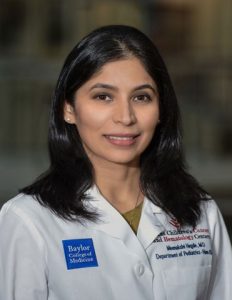Immunotherapies, one of the newest and most promising types of cancer treatments, use various methods to harness the body’s immune cells to fight cancer. Although these breakthrough therapies are providing hope for many patients in whom traditional treatments fail, scientists are still figuring out how to make them more effective for childhood cancers, especially solid tumors such as sarcomas.
 Sarcomas affect connective tissues such as muscle and fat and tend to occur in children and teenagers more than adults. With support from a V Foundation translational grant, Meenakshi Hegde, M.D., from Texas Children’s Hospital, aims to help children with these cancers benefit from CAR T-cell therapy, an immunotherapy in which some of a patient’s T-cells are equipped with a special receptor called “CAR” that helps them find and kill tumor cells expressing the protein HER2.
Sarcomas affect connective tissues such as muscle and fat and tend to occur in children and teenagers more than adults. With support from a V Foundation translational grant, Meenakshi Hegde, M.D., from Texas Children’s Hospital, aims to help children with these cancers benefit from CAR T-cell therapy, an immunotherapy in which some of a patient’s T-cells are equipped with a special receptor called “CAR” that helps them find and kill tumor cells expressing the protein HER2.
Although two FDA-approved CAR T-cell therapies work well in some adults and children with leukemia, these treatments target a molecule on cancer cells that is not present in sarcomas or other solid cancers. “We’re working to tweak the CAR T-cell treatment or use other agents to modify the sarcoma tumors so that patients have a higher likelihood of benefit,” said Hegde. “We are studying this treatment in children who haven’t responded to any other treatment with the hope of developing immunotherapies that can be used as a standard treatment rather than a last resort.”
A complex tumor environment
Sarcomas are difficult to treat with immunotherapies because they are made of a complex mixture of tumor cells, other supporting cells and immune cells equipped with inhibitory machinery, allowing them to ward off the body’s normal defenses as well as CAR-enhanced T-cells. To defeat these protections, Hegde’s research team is refining ways to design and deliver the CAR T-cell therapy so the enhanced T-cells are better prepared to seek out and eliminate cancer cells.
“The cell cultures and animal models typically used to study CAR T-cell treatment for cancer can’t completely recapitulate the complexities of the sarcoma tumor environment in the human body,” said Hegde. “We recently completed a very carefully designed clinical trial to test the safety and to determine the maximum dose for our treatment in children with sarcoma. We want to learn as much as we can from these patients to make CAR T-cell treatments better.”
The researchers are already seeing very promising signals. A child with sarcoma that had spread to other parts of the body and had not responded to standard first- or second-line treatments achieved a complete response after receiving the CAR T-cell treatment. Although he experienced a recurrence, a second CAR T-cell treatment was successful. He has remained in remission without any evidence of cancer for more than five years after starting treatment on this clinical trial. This work was published in Nature Communications.
“It’s not often that we see this type of response in a safety trial for this kind of treatment,” said Hegde. “We think that the repeat dose of CAR T-cells may have signaled other parts of his immune system to mount a response against cancer.” The researchers are continuing to study this immune response and are also working to develop ways to curtail the high levels of inflammation that can accompany the treatments.
Combining treatments
Now that they’ve established a safe dosage, the researchers will soon be starting a new clinical study that will combine their CAR T-cell treatment with another immunotherapy known as a checkpoint inhibitor that helps the body’s natural immune defenses work better against cancer. They are also testing a new genetic modification to CAR T-cells designed to target the HER2 protein on cancer cells to enable simultaneous checkpoint inhibition. The researchers think that the new T cell product could potentially improve tumor responses after infusion into the patient.
“We are one of the first groups to study what happens to the patient’s immune system in response CAR T-cell treatments,” said Hegde. “We are also hoping to test our new treatment T-cell product in people for the first time in the next few years.”
Hegde says that the V Foundation funding was extremely helpful in moving this research forward. “It is important to learn from clinical trials, but it isn’t always easy to get funding for research that takes this approach,” she said. “This funding has helped move us closer to our long-term goal of finding rational combination treatments that improve response rates and outcomes for these patients who do not benefit from conventional chemotherapy.”




